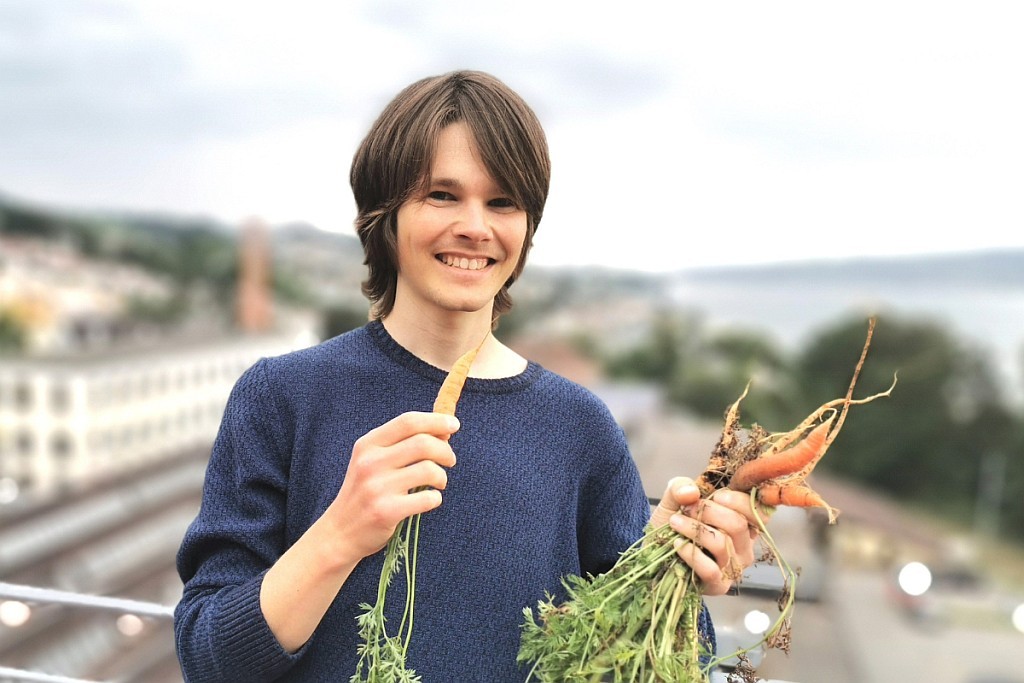Food waste in Switzerland: 5 questions for Claudio Beretta

Today, around one third of all food produced for human consumption is thrown away. That’s about 2.8 million tons per year for the whole of Switzerland, and contributes to emissions and climate change. Claudio Beretta, scientific assistant for sustainability and food waste prevention in food systems at the Zurich University of the Applied Sciences, has made it his career’s work to tackle this very issue. To mark the International Day of Awareness of Food Loss and Waste 2022 (29 September) we sat down with him to chat about Switzerland’s role in tackling food waste.
How is Switzerland doing when it comes to the issue of food waste?
A lot better than it used to be! Over the past decade public information and awareness around food waste has improved dramatically. People understand the topic much more now and know that a lot can be achieved with relatively small changes. But there’s still this startling statistic: for every person in Switzerland, 300 kilograms of food that would be perfectly safe to consume is thrown away every year. There’s a lot more being implemented at the national level, too, like the Federal Government’s plan to halve food waste by 2030 compared to 2017’s baseline.
What are the main challenges to making progress in this field?
Nobody can solve this issue alone. The retail trade can’t due to business constraints and high consumer expectations. Households also bear some responsibility. Consumers want to come into the shop just before it closes and find their favorite type of bread or pastry, or whatever it is, on the shelf. This puts retail stores under pressure to offer as diverse a range as possible – and that is only possible by overproducing. If households didn’t buy more than they needed and were not tempted by advertising, then the retail trade as it is today would operate entirely differently – and far, far less would be wasted.
Then there’s consumer perception of what’s ‘safe’ to eat, although this is in flux. With some products, there’s the risk of foodborne diseases like salmonella and listeria, which is why they have a ‘Use by’ date on them. But for a lot of foods, the ‘Best before’ label doesn’t mean much at all and these products are still fine to eat if they smell and taste alright. But convincing consumers to trust their senses here isn’t as easy as you’d think.
What are the key opportunities in your opinion – and what are you working on at the moment?
Breads and baked goods are the most wasted foods, hands down. These are followed by fresh fruit and vegetables – especially potatoes. So there are opportunities for retailers and companies in these categories to help tackle food waste and sign up to initiatives that help redistribute food and reduce food losses.
The law and question of liability is still a bit vague around distributing food past its sell-by or best before date, so more clarity is needed here. Retailers are reluctant to give away foods that are technically safe to consume, but that are past their best-before date. Part of my work at the moment is revising the guidelines to make them much clearer – which should remove some of the ambiguity and make companies more likely to get involved. If retailers decided to start selling products past their best-before date combined with an effective communication campaign, I believe that this would really help consumers to understand that these products are still safe and empower them to trust their senses.
Tell us about a few Swiss initiatives that are working in this space.
Foodwaste.ch has a great list of Swiss food waste initiatives on their website. There are so many great projects – it’s difficult to choose just a few! All of them make a hugely valuable contribution to the ambitious goal of halving food waste by 2030. I love initiatives that tackle the root cause of the problem. Foodoo, for example, collects vegetables that can’t be sold through standard retail channels and produces products like bouillon and ketchup that are usually imported. They also often organize Factory Events that help to raise consumer awareness, which doubles their impact.
Schweizer Tafel also provides a solution-based concept based on food donations. Surplus food is collected from major distributors and distributed to social institutions such as soup kitchens and women’s shelters. Smaller shops are currently less likely to be involved. But there are now various ways for retail outlets of all sizes to offer food for pick-up if it would otherwise go to waste, like the foodsharing Switzerland network and the app Too Good To Go. The only limitation for these solutions is the number of consumers who participate. I’d love to see more people discovering how easy it is to save food from retail and restaurants and how much money they can save while making a contribution to tackling the climate crisis.
So what can we do to combat waste?
As consumers, we can simply use our senses. It sounds so simple, but we are often slaves to dates. Best-before dates are a guide, not the gospel – smell it, check the food for any signs of mould, taste a little if it looks alright. Also, shop less and more consciously. Plan your meals in advance and check the fridge before you go shopping.
You can also use your voice as a consumer to drive change and reshape our food systems. Give feedback, purchase from the businesses that are making commitments in this space and show that tackling waste matters.
About Claudio Beretta
Claudio Beretta is the scientific assistant for sustainability and food waste prevention in food systems at ZHAW. His expertise and research interests include sustainability in food value chains, quantification, environmental assessment, and reduction of food losses. He completed his PhD on the Environmental Impact of Food Losses and the Reduction Potential in Food Value Chains in 2018 at ETH Zürich. Claudio is also President of foodwaste.ch.
Never miss a Swiss food innovation morsel.
Latest News
Nestlé and IBM leverage AI and deep tech to unlock new packaging innovations
Valley partner, Nestlé R&D has...
GoNina secures new funding from the Migros Pioneer Fund in its mission to reduce food waste
Swiss foodtech startup GoNina has...
Bühler Scale-Up Day accelerates industry and start-up collaboration
Valley partner Bühler is making...
What if talent – not tech – is the missing ingredient in building food system resilience?
What if talent – not tech – is the...




